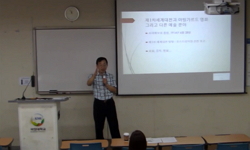Background and Purpose The primary mechanism underlying paramedian pontine infarction (PPI) is atheroma obliterating the perforators. Here, we encountered a patient with PPI in the post-stenotic area of basilar artery (BA) without a plaque, shown by h...
http://chineseinput.net/에서 pinyin(병음)방식으로 중국어를 변환할 수 있습니다.
변환된 중국어를 복사하여 사용하시면 됩니다.
- 中文 을 입력하시려면 zhongwen을 입력하시고 space를누르시면됩니다.
- 北京 을 입력하시려면 beijing을 입력하시고 space를 누르시면 됩니다.
https://www.riss.kr/link?id=A103568421
-
저자
Bum Joon Kim (Department of Neurology, University of Ulsan College of Medicine, Seoul, Korea) ; Hojin Ha (Center for Biofluid and Biomimic Research,Pohang University of Science and Technology, Pohang, Korea) ; Hyung Kyu Huh (Center for Biofluid and Biomimic Research,Pohang University of Science and Technology, Pohang, Korea) ; Guk Bae Kim (Asan Institute of Life Science, Asan Medical Center, Seoul, Korea) ; Jong S. Kim (Department of Neurology, University of Ulsan College of Medicine, Seoul) ; Namkug Kim (Asan Institute of Life Science, Asan Medical Center, Seoul, Korea) ; Sang-Joon Lee (Center for Biofluid and Biomimic Research,Pohang University of Science and Technology, Pohang, Korea) ; Dong-Wha Kang (Department of Neurology, Asan Medical Center, University of Ulsan College of Medicine, Seoul, Korea) ; Sun U. Kwon (Department of Neurology, University of Ulsan College of Medicine, Seoul, Korea)

- 발행기관
- 학술지명
- 권호사항
-
발행연도
2016
-
작성언어
-
- 주제어
-
등재정보
KCI등재,SCIE,SCOPUS
-
자료형태
학술저널
- 발행기관 URL
-
수록면
66-72(7쪽)
-
KCI 피인용횟수
4
- 제공처
- 소장기관
-
0
상세조회 -
0
다운로드
부가정보
다국어 초록 (Multilingual Abstract)
Background and Purpose The primary mechanism underlying paramedian pontine infarction (PPI) is atheroma obliterating the perforators. Here, we encountered a patient with PPI in the post-stenotic area of basilar artery (BA) without a plaque, shown by high-resolution magnetic resonance imaging (HR-MRI). We performed an experiment using a 3D-printed BA model and a particle image velocimetry (PIV) to explore the hemodynamic property of the post-stenotic area and the mechanism of PPI.
Methods 3D-model of a BA stenosis was reconstructed with silicone compound using a 3D-printer based on the source image of HR-MRI. Working fluid seeded with fluorescence particles was used and the velocity of those particles was measured horizontally and vertically. Furthermore, microtubules were inserted into the posterior aspect of the model to measure the flow rates of perforators (pre-and post-stenotic areas). The flow rates were compared between the microtubules.
Results A recirculating flow was observed from the post-stenotic area in both directions forming a spiral shape. The velocity of the flow in these regions of recirculation was about one-tenth that of the flow in other regions. The location of recirculating flow well corresponded with the area with low-signal intensity at the time-of-flight magnetic resonance angiography and the location of PPI. Finally, the flow rate through the microtubule inserted into the post-stenotic area was significantly decreased comparing to others (P<0.001).
Conclusions Perforator infarction may be caused by a hemodynamic mechanism altered by stenosis that induces a recirculation flow. 3D-printed modeling and PIV are helpful understanding the hemodynamics of intracranial stenosis.
참고문헌 (Reference)
1 Kim BJ, "The shape of middle cerebral artery and plaque location : high-resolution MRI finding" 10 : 856-860, 2015
2 Zhang JN, "Platelet aggregation and activation under complex patterns of shear stress" 88 : 817-821, 2002
3 Kim BJ, "Perforator infarction immediately distal to the stenosis of parental artery: is it hemodynamic?" 23 : 1991-1993, 2014
4 Jeong J, "On the identification of a vortex" 285 : 69-94, 1995
5 Dubief Y, "On coherent-vortex identification in turbulence" 1 : 011-, 2000
6 Zhao R, "Micro-flow visualization of red blood cell-enhanced platelet concentration at sudden expansion" 36 : 1130-1141, 2008
7 Leng X, "Magnetic resonance angiography signal intensity as a marker of hemodynamic impairment in intracranial arterial stenosis" 8 : e80124-, 2013
8 Bassetti C, "Isolated infarcts of the pons" 46 : 165-175, 1996
9 Goubergrits L, "In vitro study of near-wall flow in a cerebral aneurysm model with and without coils" 31 : 1521-1528, 2010
10 Klein IF, "High-resolution MRI identifies basilar artery plaques in paramedian pontine infarct" 64 : 551-552, 2005
1 Kim BJ, "The shape of middle cerebral artery and plaque location : high-resolution MRI finding" 10 : 856-860, 2015
2 Zhang JN, "Platelet aggregation and activation under complex patterns of shear stress" 88 : 817-821, 2002
3 Kim BJ, "Perforator infarction immediately distal to the stenosis of parental artery: is it hemodynamic?" 23 : 1991-1993, 2014
4 Jeong J, "On the identification of a vortex" 285 : 69-94, 1995
5 Dubief Y, "On coherent-vortex identification in turbulence" 1 : 011-, 2000
6 Zhao R, "Micro-flow visualization of red blood cell-enhanced platelet concentration at sudden expansion" 36 : 1130-1141, 2008
7 Leng X, "Magnetic resonance angiography signal intensity as a marker of hemodynamic impairment in intracranial arterial stenosis" 8 : e80124-, 2013
8 Bassetti C, "Isolated infarcts of the pons" 46 : 165-175, 1996
9 Goubergrits L, "In vitro study of near-wall flow in a cerebral aneurysm model with and without coils" 31 : 1521-1528, 2010
10 Klein IF, "High-resolution MRI identifies basilar artery plaques in paramedian pontine infarct" 64 : 551-552, 2005
11 Ha H, "Fluid-dynamic optimal design of helical vascular graft for stenotic disturbed flow" 9 : e111047-, 2014
12 Wootton DM, "Fluid mechanics of vascular systems, diseases, and thrombosis" 1 : 299-329, 1999
13 Yagi T, "Experimental insights into flow impingement in cerebral aneurysm by stereoscopic particle image velocimetry : transition from a laminar regime" 10 : 20121031-, 2013
14 Bo Norrving, "Evolving Concept of Small Vessel Disease through Advanced Brain Imaging" 대한뇌졸중학회 17 (17): 94-100, 2015
15 Schwartz A, "Dolichoectatic intracranial arteries : review of selected aspects" 3 : 273-279, 1993
16 Kwon HM, "Basilar artery dolichoectasia is associated with paramedian pontine infarction" 27 : 114-118, 2009
17 Mehdiratta M, "Basilar artery branch disease imaged by magnetic resonance imaging" 64 : 1666-, 2007
18 Choi JY, "Analysis of errors in medical rapid prototyping models" 31 : 23-32, 2002
동일학술지(권/호) 다른 논문
-
Moyamoya Disease: Treatment and Outcomes
- 대한뇌졸중학회
- 김택균
- 2016
- KCI등재,SCIE,SCOPUS
-
Susceptibility-Weighted Imaging for Detection of Thrombus in Acute Cardioembolic Stroke
- 대한뇌졸중학회
- Min-Gyu Park
- 2016
- KCI등재,SCIE,SCOPUS
-
The Pathophysiology of Moyamoya Disease: An Update
- 대한뇌졸중학회
- 방오영
- 2016
- KCI등재,SCIE,SCOPUS
-
Chronic Management of Hypertension after Stroke: The Role of Ambulatory Blood Pressure Monitoring
- 대한뇌졸중학회
- Luis Castilla-Guerra
- 2016
- KCI등재,SCIE,SCOPUS
분석정보
인용정보 인용지수 설명보기
학술지 이력
| 연월일 | 이력구분 | 이력상세 | 등재구분 |
|---|---|---|---|
| 2023 | 평가예정 | 해외DB학술지평가 신청대상 (해외등재 학술지 평가) | |
| 2020-01-01 | 평가 | 등재학술지 유지 (해외등재 학술지 평가) |  |
| 2014-11-01 | 평가 | SCIE 등재 (기타) |  |
| 2013-01-01 | 평가 | 등재후보학술지 유지 (기타) |  |
| 2011-01-01 | 평가 | 등재후보학술지 선정 (신규평가) |  |
학술지 인용정보
| 기준연도 | WOS-KCI 통합IF(2년) | KCIF(2년) | KCIF(3년) |
|---|---|---|---|
| 2016 | 3.63 | 0.55 | 3.13 |
| KCIF(4년) | KCIF(5년) | 중심성지수(3년) | 즉시성지수 |
| 2.37 | 1.91 | 1.175 | 0.1 |






 ScienceON
ScienceON







